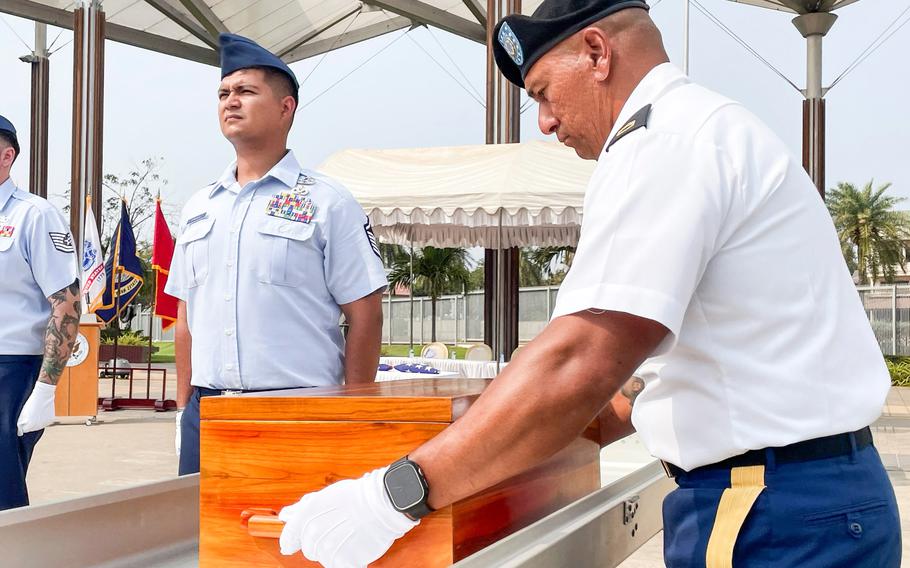
U.S. Army Sgt. 1st Class Patrick Tinae, a team leader with the Defense POW/MIA Accounting Agency, places a transfer case containing remains, potentially those of a U.S. service member, into a casket during a remembrance ceremony in Vientiane, Laos, on Feb. 19, 2025. (David Owsianka/U.S. Air Force)
The Defense POW/MIA Accounting Agency’s forensic lab in Hawaii has begun analyzing dozens of human remains retrieved from Laos and the Philippines in recent weeks.
During a remembrance ceremony Wednesday in Vientiane, Laos, the agency received remains that might be those of U.S. personnel lost there during the Vietnam War.
On Jan. 28, the agency conducted an honorable carry ceremony in Hawaii with 18 U.S. flag-draped cases containing the potential remains of another 36 service members killed during World War II and interred as unknowns at the Manila American Cemetery and Memorial in the Philippines.
The Laos remains came from multiple locations in that country, which shares a border with Vietnam, DPAA said in an email Wednesday. There are 1,573 service members still unaccounted for from the Vietnam War, with the remains of more than 280 of them believed to be in Laos, the message said.
Remembrance ceremonies are held in the country in which remains are found. The transfer cases are wrapped in U.S. flags by the DPAA team members who recovered them, according to the agency.
“We conduct these types of ceremonies to provide the respect and recognition they deserve,” the email said.
The honorable carry ceremony for the Philippines remains was held at Joint Base Pearl Harbor-Hickam, home of the DPAA lab. In contrast to a remembrance ceremony, the honorable carry is a tradition marking a missing service member’s return to U.S. soil.
“Thirty-five of these brave individuals perished in captivity at the Cabanatuan prison camp, while one gave their life in the Tokyo Prison Fire during World War II,” John Figuerres, DPAA’s acting deputy director for operations, said in a Feb. 3 news release.
The unidentified service members were among the troops who waged the battles of Bataan and Corregidor as the Japanese invaded and captured the Philippines in 1942.
“After being forced to surrender, many of these service members suffered through the brutal 65-mile Bataan Death March and lost their lives while being held as prisoners,” Figuerres said.
The brutal and stark Cabanatuan prison held tens of thousands of U.S. and Filipino POWs.
By the time the camp was liberated in January 1945, the remains of more than 2,700 POWs had been buried in common graves, according to a DPAA online fact sheet.
“At the end of the postwar identification effort, over a third of these remains were unidentified,” the fact sheet states.
DPAA launched the Cabanatuan Project in 2014, which has since led to the identification and accounting of more than 90 service members, with more than 900 unknowns awaiting identification, the Feb. 7 news release states.
The agency’s goal is to exhume and transfer about 70 cases of remains each year, the release states.
The Tokyo Prison Fire Project was initiated in 2022 to identify the remains of American POWs killed during the U.S. firebombing of Tokyo on May 26, 1945. After World War II, dozens of unidentifiable remains associated with the prison were buried at the Manila cemetery.
In January, the DPAA announced it had identified the remains of U.S. Army Air Forces 2nd Lt. Justice J. Buttala, who was among those killed in the prison. He was the second POW to be accounted for by the project.
Buttala, an observer aboard a B-29 Superfortress, was shot down April 24, 1945, while on a bombing mission over Tachikawa in western Tokyo.
The American Graves Registration Service was unable to identify him after the war, and his remains were buried in an unknown grave in Manila. DPAA exhumed the remains in 2022 for forensic analysis in Hawaii.